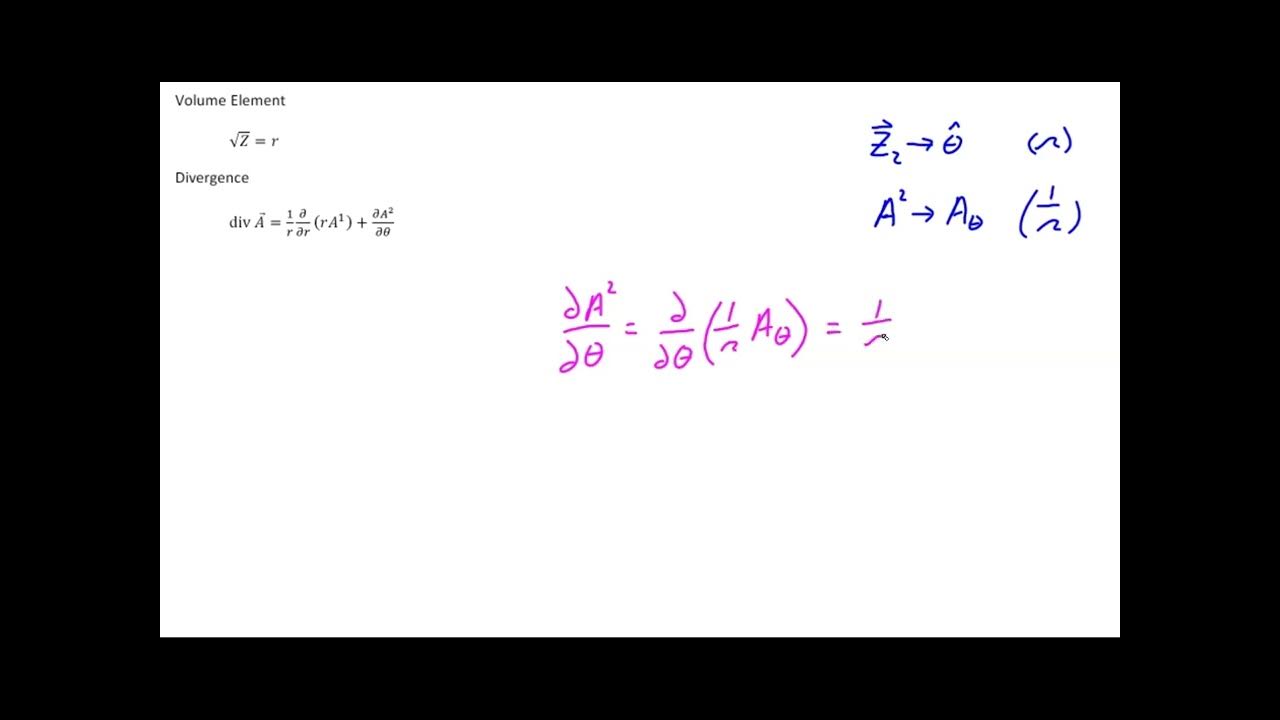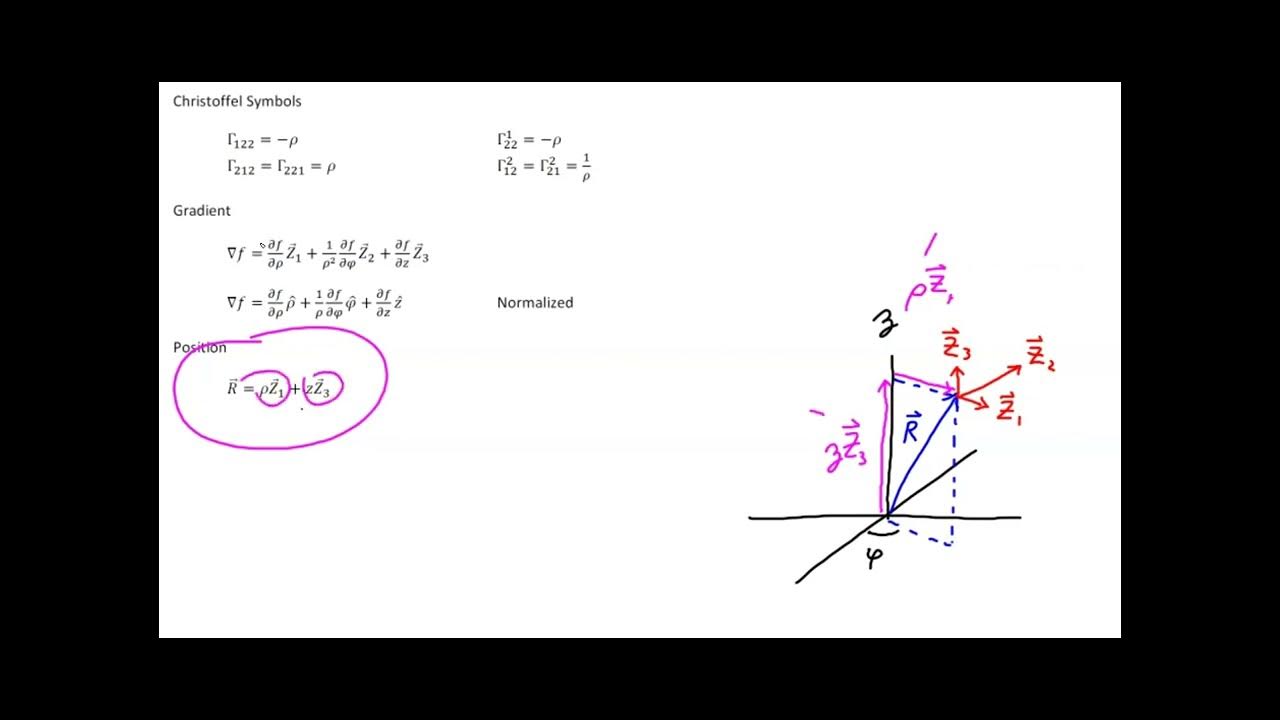Video 56 - Cross Product & Curl Examples
TLDRThis video script from a tensor calculus series explores the cross product and curl in various coordinate systems. It simplifies the process by reorganizing expressions and identifying patterns, demonstrating how to calculate these operations efficiently in Cartesian, cylindrical, spherical, affine, and plane polar coordinates. The script emphasizes the importance of permutation techniques and careful substitution for normalization in higher dimensions, while noting the undefined nature of curl in two dimensions.
Takeaways
- 📚 The video discusses the cross product and curl in various coordinate systems, focusing on simplifying expressions and identifying patterns.
- 🔍 It emphasizes the importance of Levi-Civita symbols' skew symmetry in reducing the number of terms needed for calculations.
- 📐 The script demonstrates how to reorganize the cross product expression for easier computation and pattern recognition.
- 🔄 The video introduces a permutation technique to derive expressions for different components of the cross product and curl by inspection.
- 📈 The cross product's first component is derived using specific Levi-Civita symbols and is then extended to other components through permutation.
- ⚙️ The curl's expression is shown to have a similar structure to the cross product, differing mainly in the middle terms.
- 🌐 Cartesian coordinates are used as an example to illustrate the application of the derived pattern for the cross product and curl.
- 📊 Cylindrical polar coordinates are discussed, including the normalization of results and careful substitution due to non-constant factors.
- 🌍 Spherical polar coordinates follow a similar pattern, with the volume element and basis vector normalizations affecting the final expressions.
- 🛑 The script notes that the curl is undefined in two-dimensional systems, such as affine and plane polar coordinates.
- 📝 For two-dimensional systems, a specific formula for the cross product is provided, highlighting the unique properties of 2D calculations.
Q & A
What is the main topic discussed in video 56 of tensor calculus?
-The main topic discussed in video 56 is the demonstration of the cross product and curl in various sample coordinate systems.
Why are only six terms of the Levi-Civita symbols considered in the video?
-Only six terms of the Levi-Civita symbols are considered because they are skew-symmetric, which reduces the number of unique terms needed to be examined.
What is the significance of the epsilon symbol (ε) used in the video?
-The epsilon symbol (ε) is used to represent the Levi-Civita symbol, which is crucial in the calculation of the cross product and curl in different coordinate systems.
How does the video simplify the expression for the cross product in different coordinate systems?
-The video simplifies the expression by factoring out common terms and using the permutation of indices to derive other components from the first term.
What is the pattern observed in the expressions for the cross product in the video?
-The pattern observed is that all expressions have a common factor, a pair of terms subtracted from each other, and a basis vector, with the difference being the permutation of indices.
How does the video relate the cross product to the curl in terms of expression?
-The video shows that the curl expression is almost identical to the cross product, with the main difference being the terms in the middle and the use of indexes j and k.
What is the volume element for Cartesian coordinates, and how does it affect the cross product and curl expressions?
-The volume element for Cartesian coordinates is 1, which means it does not affect the cross product and curl expressions as there is no factor in front of the terms.
How does the video handle the normalization of the cross product and curl in cylindrical polar coordinates?
-The video handles normalization by making appropriate substitutions for the basis vectors, taking into account their magnitudes, and ensuring that factors dependent on the differentiation variable remain inside the differentiation parentheses.
What is the significance of the permutation technique mentioned in the video?
-The permutation technique allows for the quick derivation of the second and third components of the cross product and curl from the first component by simply permuting the indices.
Why is the curl undefined in two-dimensional systems according to the video?
-The curl is undefined in two-dimensional systems because it is a measure of the rotation of a vector field, which is a concept that inherently requires three dimensions.
How does the video derive the cross product expression for two-dimensional systems like affine and plane polar coordinates?
-The video derives the cross product expression for two-dimensional systems by using the epsilon symbol for two dimensions, which has only two non-zero values, and then substituting the appropriate volume elements for each coordinate system.
What is the final expression for the cross product in affine coordinates after substituting the contravariant vector components?
-The final expression for the cross product in affine coordinates involves substituting the contravariant vector components using the covariant metric tensor to lower the indices, resulting in a linear combination of the original vector components with the covariant basis vectors.
How does the video normalize the cross product in plane polar coordinates?
-The video normalizes the cross product in plane polar coordinates by substituting the appropriate values for the basis vectors, considering their magnitudes, and simplifying the expression to get the normalized result.
Outlines
📚 Tensor Calculus: Cross Product and Curl in Sample Coordinate Systems
In this segment, the video script discusses the demonstration of the cross product and curl in various sample coordinate systems. The focus is on reorganizing the expression for the Levi-Civita symbol, which is skew-symmetric, to simplify the process. The script explains how to calculate the cross product components using epsilon symbols and how to derive the curl expression by substituting the cross product into the curl formula. The key takeaway is the simplification of the process by recognizing patterns and using permutation techniques to avoid repetitive calculations.
🔍 Simplifying Cross Product Expressions and Introducing Curl
This paragraph delves deeper into the simplification of cross product expressions by examining the properties of the Levi-Civita symbol and its relationship with the epsilon symbols. The script outlines how to rewrite the expression for the first component of the cross product and how to apply permutation techniques to derive the other components. It also introduces the curl expression and demonstrates how to obtain similar results by using the cross product's index permutation method. The emphasis is on the ease of deriving expressions by inspection once the initial term is established.
📘 Applying the Cross Product and Curl in Cartesian and Cylindrical Coordinates
The script moves on to apply the derived patterns for the cross product and curl in Cartesian and cylindrical polar coordinates. For Cartesian coordinates, the volume element is 1, simplifying the expressions. The process of permutation is used to find all components of the cross product and curl. For cylindrical polar coordinates, the volume element is rho, and the script explains how to write down the results by inspection and permute the indexes to find the curl components. The paragraph also touches on the normalization of results in cylindrical coordinates, emphasizing the importance of careful substitution to avoid errors in differentiation.
🌐 Normalizing Cross Product and Curl in Spherical and Cylindrical Coordinates
The focus shifts to normalizing the cross product and curl in spherical and cylindrical polar coordinates. The script explains the importance of making appropriate substitutions based on the contravariant and covariant basis vectors. For spherical polar coordinates, the volume element is r squared sine theta, and the script demonstrates how to substitute and simplify the expressions to get the normalized results. Special attention is given to the careful handling of factors during substitution to ensure accuracy in differentiation. The paragraph also notes the undefined nature of curl in two-dimensional systems.
📏 Cross Product and Curl in Two-Dimensional Systems
The final paragraph addresses the cross product and curl in two-dimensional systems, specifically affine and plane polar coordinates. The script provides the formula for the cross product in two dimensions and demonstrates how to derive the expression by hand. It explains the process of normalization for the cross product in plane polar coordinates and the use of contravariant vector components. The paragraph concludes by noting that the curl is not applicable in two-dimensional systems, thus wrapping up the discussion on the topic.
Mindmap
Keywords
💡Cross Product
💡Curl
💡Levi-Civita Symbol
💡Skew-Symmetric
💡Permutation
💡Coordinate Systems
💡Volume Element
💡Normalization
💡Basis Vectors
💡Partial Derivative
💡Tensor Calculus
Highlights
Introduction to demonstrating the cross product and curl in various coordinate systems.
Reorganization of the expression for easier computation using Levi-Civita symbols.
Identification of skew-symmetry in Levi-Civita symbols to simplify calculations.
Derivation of the first component of the cross product using epsilon symbols.
Explanation of the relationship between epsilon symbols and their negative counterparts.
Pattern recognition in the cross product expressions for all sample coordinate systems.
Technique of permutation to derive cross product components without extensive calculation.
Application of the derived pattern to the curl expression in tensor calculus.
Normalization of the cross product and curl results in cylindrical polar coordinates.
Substitution of basis vectors in cylindrical polar coordinates for accurate results.
Cautionary advice on making substitutions in curl expressions to avoid errors.
Cross product and curl derivation in spherical polar coordinates using the established pattern.
Normalization of results in spherical polar coordinates with careful substitution.
Special considerations for affine and plane polar coordinates due to two-dimensional nature.
Expression of the cross product in affine coordinates using contravariant vector components.
Undefined nature of the curl in two-dimensional systems like affine and plane polar coordinates.
Cross product derivation in plane polar coordinates and its normalization.
Final summary of cross product and curl demonstrations across all sample coordinate systems.
Transcripts
5.0 / 5 (0 votes)
Thanks for rating:





